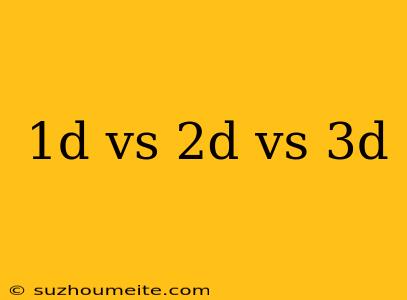1D vs 2D vs 3D: Understanding the Dimensions ==================================================================-==-=-=-=-=-=-==-
In the world of mathematics, physics, and computer graphics, dimensions play a crucial role in understanding and representing objects and spaces. In this article, we will explore the differences between 1D, 2D, and 3D dimensions, and how they are used in various fields.
What are Dimensions?
A dimension is a fundamental concept in mathematics that refers to the extent or measurement of an object or space in a particular direction. It is a way to quantify and describe the properties of an object or space.
1D Dimension (One-Dimensional)
A 1D object or space has only one dimension, which means it can be measured and described using a single axis or direction. Examples of 1D objects include:
- A line segment
- A number line
- A musical note (with only one frequency)
In 1D, there is no concept of width, height, or depth. Objects can only be measured and moved along a single axis.
2D Dimension (Two-Dimensional)
A 2D object or space has two dimensions, which means it can be measured and described using two axes or directions. Examples of 2D objects include:
- A piece of paper
- A screen display
- A photograph
In 2D, there is no concept of depth. Objects can be measured and moved along two axes, typically represented by the x-axis and y-axis.
3D Dimension (Three-Dimensional)
A 3D object or space has three dimensions, which means it can be measured and described using three axes or directions. Examples of 3D objects include:
- A cube
- A sphere
- A human body
In 3D, objects can be measured and moved along three axes, typically represented by the x-axis, y-axis, and z-axis.
Applications in Real-World Scenarios
Dimensions are used in various fields, including:
- Computer Graphics: 2D and 3D graphics are used in video games, animation, and film to create realistic environments and characters.
- Physics and Engineering: Dimensions are used to describe and analyze the properties of objects and systems, such as velocity, acceleration, and force.
- Mathematics: Dimensions are used to describe and analyze geometric shapes, including points, lines, and curves.
- Medical Imaging: 2D and 3D imaging techniques are used in medical imaging to create detailed images of the body.
Conclusion
In conclusion, understanding the differences between 1D, 2D, and 3D dimensions is crucial in various fields, including mathematics, physics, computer graphics, and more. By recognizing the unique properties and applications of each dimension, we can better understand and describe the world around us.
